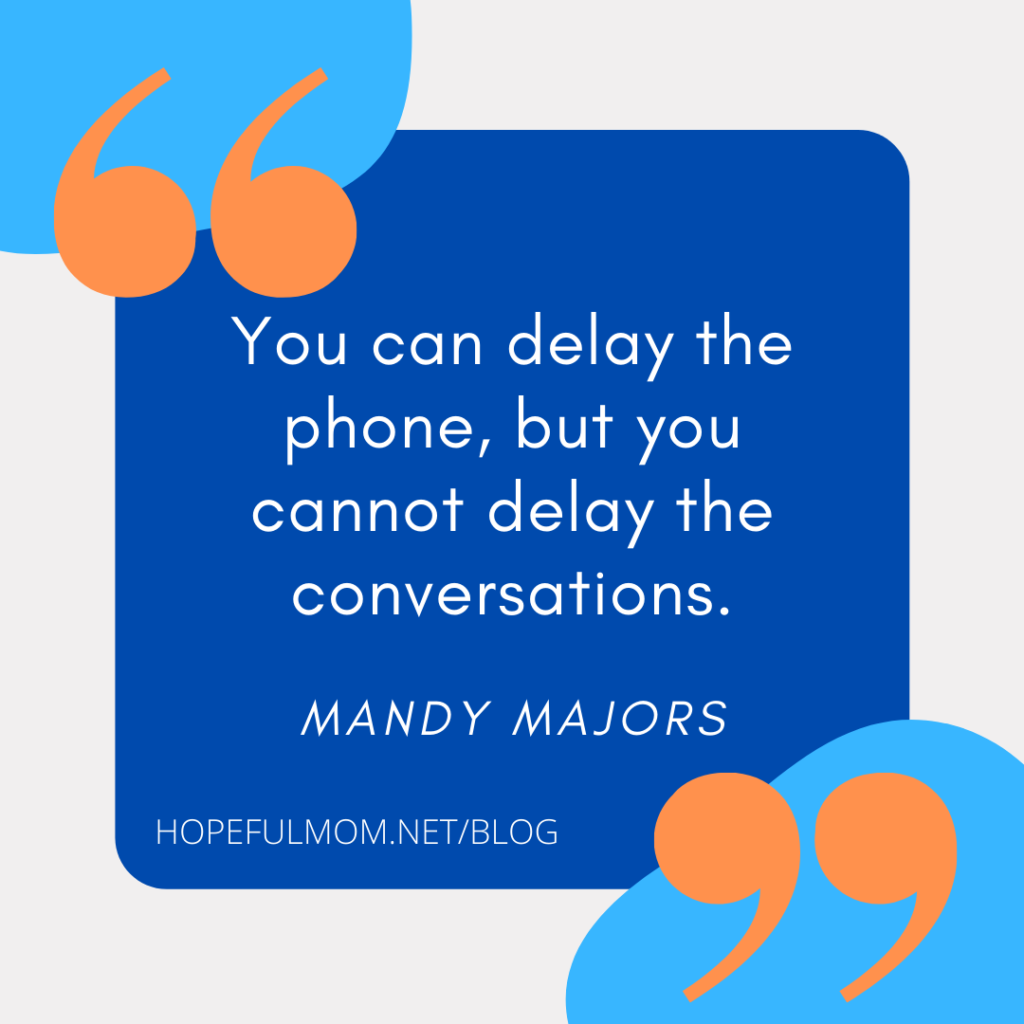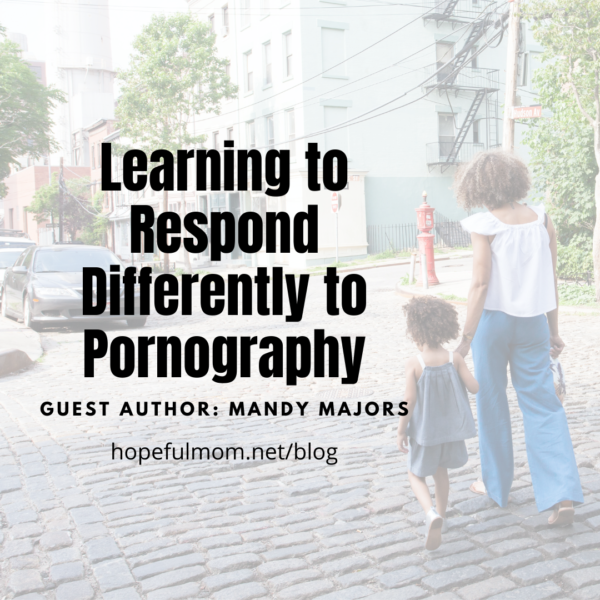I’m privileged to welcome Mandy Majors as a guest author. I love Mandy’s down-to-earth, matter-of-fact, easygoing way of addressing hard topics. She is passionate about creating a culture of open communication and honest conversation in homes, churches and schools to keep kids safe in a digital world – and this attitude is reflected in her podcast and writings. Her popular podcast, nextTalk, is a must-listen for today’s parents.
One morning as we were getting ready for school, my daughter asked a question I wasn’t prepared for. It was highly sexualized. This was not a “where do babies come from” question. I didn’t know this “thing” existed until I was a nineteen-year-old college student. She was NINE!
I eventually discovered another fourth grader had watched a sexually graphic video at home and shared the graphic details at school. My nine-year-old daughter had been exposed to pornography.
That was the moment I realized parenting had changed. And, I had no idea how to respond to all her questions.
I thought we had been responsible parents by not giving her a phone. We tried to protect her, but it didn’t keep her safe from online dangers. I felt like I had been punched in the gut. Why do kids have to grow up so fast?
That was eight years ago, and I’ve been on a mission to keep kids safe ever since. Since then, I’ve written two books, started a nonprofit (nextTalk.org), spoken to thousands across six states and co-host a podcast with 100,000+ listeners in 60 countries. Most importantly, I’ve learned how to communicate with my own children about their online world. I want to explain how I’m parenting differently in light of what I’m learning.
A New Problem
When I started this journey, I first needed to identify the new problem we face. We know that technology is impacting our kids, but what does that really mean? There are things like social media, apps, screen addiction and sharing nudes; we’re the first generation of parents to tackle these new challenges. There are also issues that have been around for years, but technology has changed them … like bullying, strangers and pornography.
As I sought to find a solution to this overwhelming problem, I knew bubble wrapping (not allowing technology) failed because my child was still exposed. Once she finally earned a phone, I realized most monitoring products had loopholes. For example, there are some operating systems and apps that prevent third-party monitoring. Even if I could find the perfect app, kids use their friend’s phone when they want to hide something!
I’m not saying we shouldn’t use all of the tools that are available to us. Subscribe to the phone-monitoring apps. Set restrictions and parental controls. Do random phone checks. Implement a phone contract with clear guidelines and consequences. Be in your kids’ online world and follow them on social media. All, yes!
Open Communication
But the solution and first line of defense I’ve discovered is: open communication. It’s about having healthy, on-the-go conversations about everyday questions our kids struggle with. Real issues in real time.
You can delay the phone, but you cannot delay the conversations.

I know this “talk to your kids” solution sounds so simple. But as I’ve walked this path, I’ve discovered that open communication is more than just having a few conversations here and there. We actually need to create a culture of honest conversation. But how do we do that and what does it look like?
Let me give you an example.
Fast forward four years from the opening story. My daughter was then thirteen and had earned her first social media platform that we were learning together: Instagram.
I’m standing at the stove making tacos for dinner as she turned the corner into the kitchen, phone in her hand with eyes wide open. When I saw the expression on her face, I knew something big was about to happen.
I breathed a silent prayer: Don’t let me lose my mind when I see what she’s about to show me.
My daughter walked over and said, “I was scrolling through my Instagram feed looking at some pictures of a wedding my friends went to. The pictures of the bride and the bridesmaids’ dresses were gorgeous. In their post, they included a wedding hashtag [#wedding], so I clicked to see more dresses, and this popped up.”
She shoved her screen in front of my face, and this is what I saw: Naked. Women. On beds. In weird positions.
I paused.
Old Mandy would’ve grabbed the phone, thrown it in the trash, and said, “I tried to be cool Insta-mom, but NO! NO! NO! We’re done!”
Much to my surprise, I did none of that. Who was this new person?
New Mandy gently took the phone and placed it facedown on the kitchen counter. Then I looked my baby girl in the eyes and calmly said, “I’m so proud of you. You did nothing wrong. You were trying to look at dresses and pornography popped up. But you told me. You did everything right. Because you’re telling me about what you’re seeing online, you can pick out a new app today. Tell me what you want; then I’ll research it and see if it’s age appropriate.”
Old Mandy had inadvertently created an environment where my kids wanted to hide the bad things they saw online because they knew I’d delete the app or throw away the phone. I didn’t even know I was shutting down communication. New Mandy is learning to encourage my kids to tell me what they’re seeing and hearing online. They even get rewarded when they do!
After this conversation, I took my daughter’s phone into another room and reported the pornography to Instagram so it could be taken down. I found even more pictures than the ones my child had been exposed to, and I was struggling to process it all. In the days that followed, I had honest conversations with my girl about it. I’d crawl into bed with her at night and say, “I’m struggling to get those images out of my head.”
I can’t even tell you how much conversation that created. It opened up a whole new dialogue about why images like that are bad for us, and how they cause us to look at people as objects instead of seeing their hearts. These honest conversations were way more likely to prevent my kid from watching pornography than just yelling “No!” and throwing away the phone. I saw firsthand that relationship is so much more effective than rules.
A New Solution
Old Mandy would have missed the opportunity to have any of these conversations.
In my new book, Keeping Kids Safe in a Digital World: A Solution That Works, I share many more examples of how Old Mandy used to react and how New Mandy responds now.
When guidelines, filters, and restrictions have failed, open communication has kept my kids safe. I’ve witnessed this firsthand. App-monitoring devices aren’t catching the conversations at lunch or on the bus, but my kids are telling me. There is no doubt that technology is overexposing our kids. Instead of being overwhelmed with this new problem, spend that time building a healthy dialogue with your child. Learn to respond in a way that opens up communication, instead of shutting it down. That’s the solution that will keep your kids safe.
Thanks for reading. Please subscribe (scroll down) so you don’t miss a single post! Also share on social media. So many parents need to hear this information. You may be helping another parent/grandparent/caregiver today. Thanks to Mandy for being here. Check out her podcast and books!
About the author

Mandy Majors
Some of the above has been taken from Mandy Majors’ awarding-winning books, Keeping Kids Safe in a Digital World: A Solution That Works and TALK: A Practical Approach to Cyberparenting and Open Communication. She is a graduate of Indiana University and founder of nextTalk, a nonprofit organization that keeps kids safe online by creating a culture of conversation in families, churches, and schools. She’s been married to her best friend, Matt, for twenty-one years, and together they’re raising two teens in Texas. You can connect with Mandy on Facebook @mandymajors.author, Twitter @mandymajors, at mandymajors.com and nextTalk.org.



I always enjoy your posts! So simple and yet oozing with lots of nuggets.
Thanks so much! 🙂